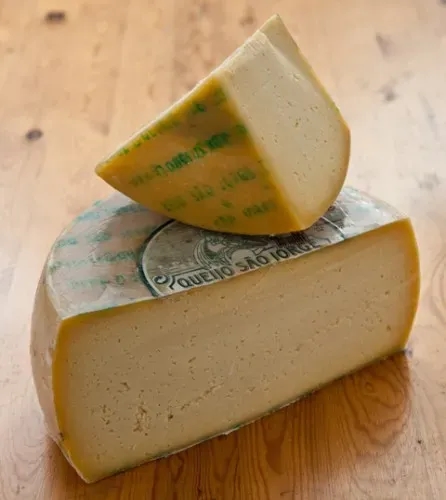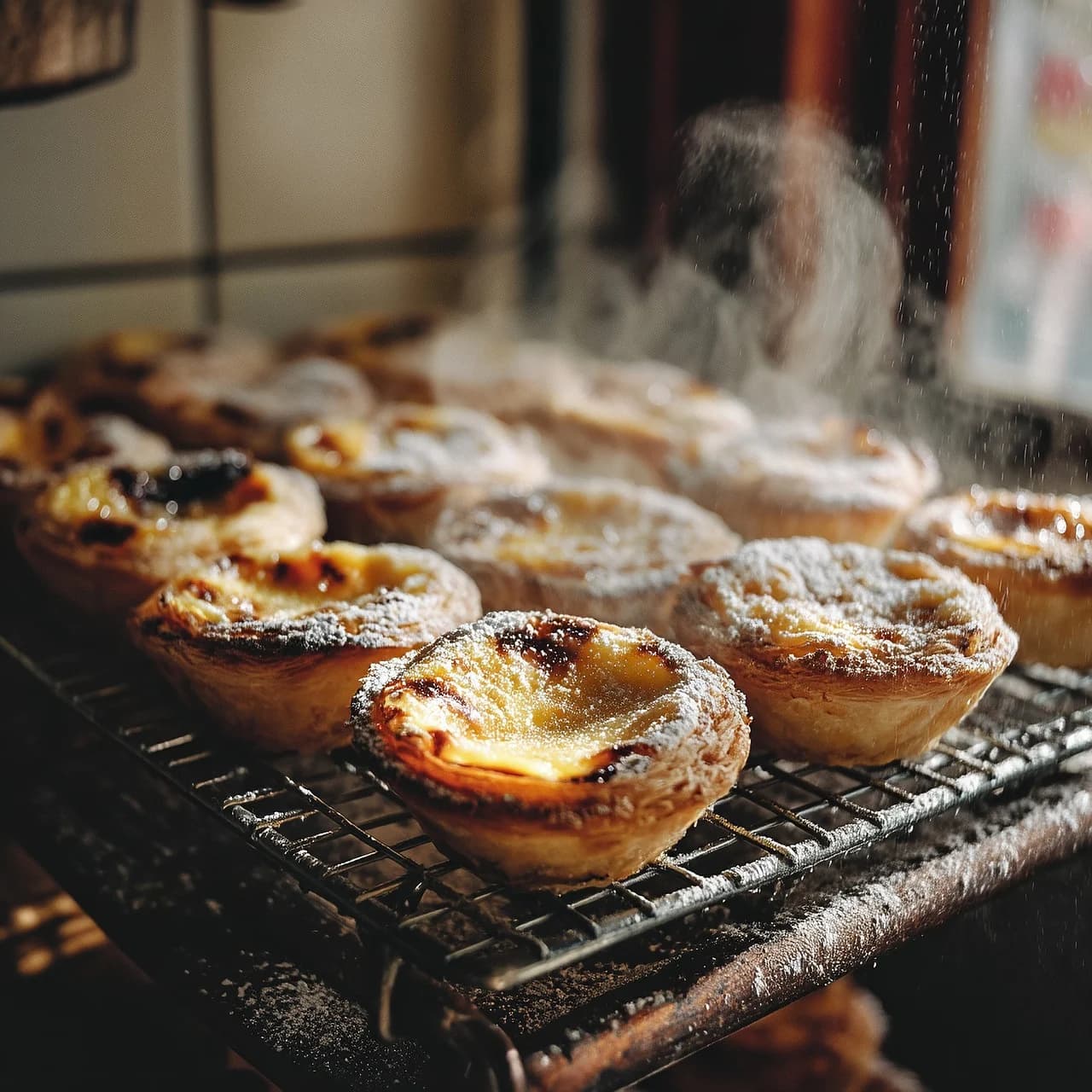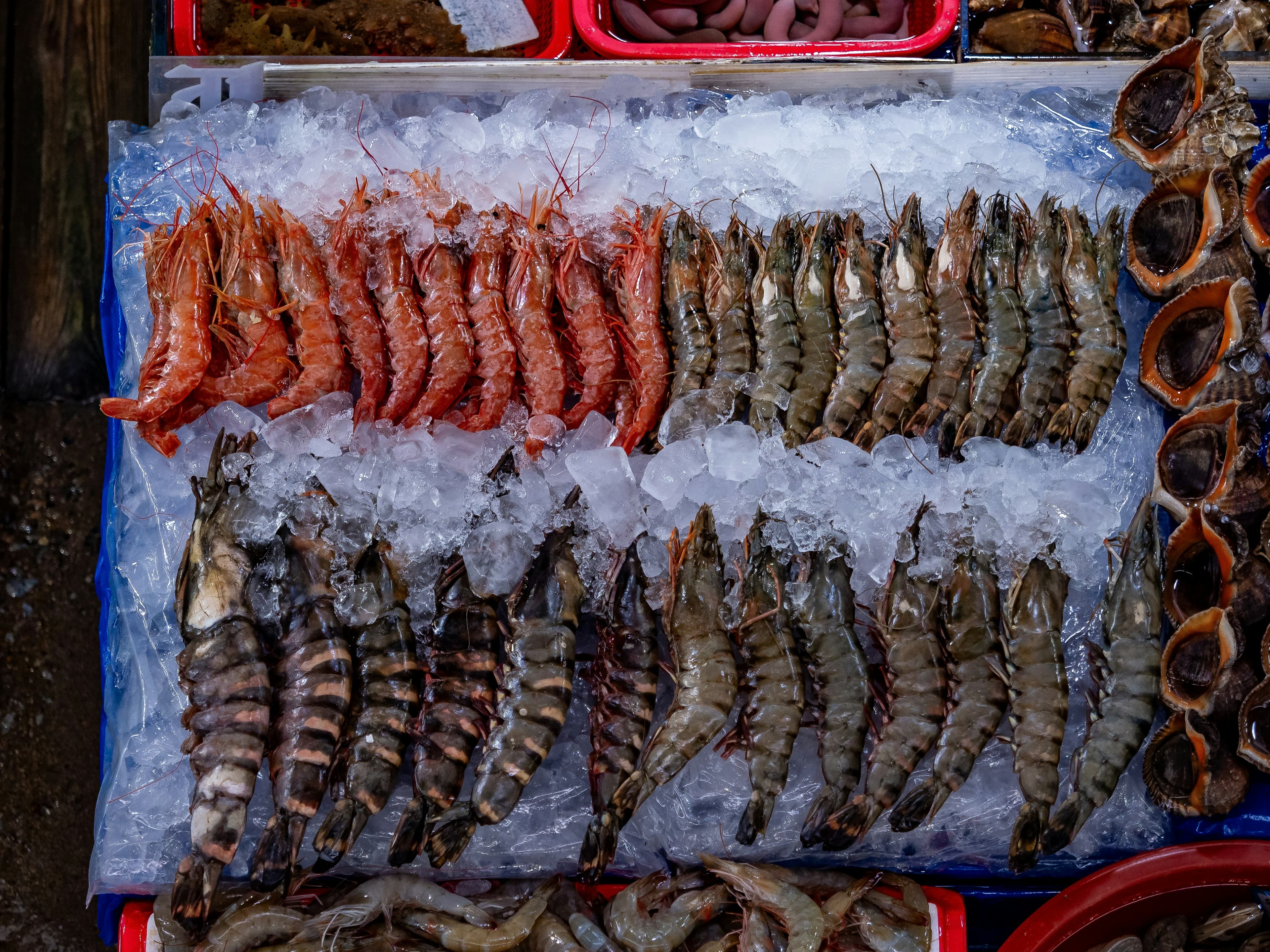
Let’s be honest : when people think of Portugal, they think first of wine, bacalhau, pastéis de nata… but rarely of cheese… And yet ! This small country hides a cheese-making heritage of incredible richness. From the mountains of Serra da Estrela to the islands of the Azores, each region has its own creamy, intense or matured gem, best enjoyed with a glass of local wine (of course). By the way, did you know that Portugal won the World Cheese Awards 2024 ? So today, let’s put down the board, grab a knife, and set off on a gourmet (and cheesy) journey through Portugal… the most melting adventure of all !
Serra da Estrela, the creamy king of the mountains
Let’s start with the noblest : the Queijo da Serra da Estrela, the true king of Portuguese cheeses ! Born in the heart of the country, among the snowy peaks of the Serra da Estrela mountains, this sheep’s milk cheese is a national monument (and not just figuratively speaking).
Its particularity ? It’s curdled not with animal rennet, but with a wild thistle flower, yes, an ancestral technique that gives it that unique, slightly herbal and terribly addictive flavour ! When you cut it open, the soft heart slowly escapes… And here, beware, it’s a test of willpower. Because you have to wait a little before diving in with your spoon (yes yes, you can really eat it with a spoon, it’s not a metaphor !).
I discovered Queijo da Serra by going directly to the source (they told me it was good, I just wanted to verify it myself !), in a small cheese shop high up in the mountains (a few metres from the ski slopes), and honestly, it was an experience in itself (with the snowy scenery and all, it was even better). Savoury, creamy… it’s the kind of culinary experience that reconciles you with winter.
Azeitão, small but mighty
Just a few kilometres from Lisbon, between hills and vineyards, hides another treasure : Queijo de Azeitão. Small, round, and perfectly soft, this raw sheep’s milk cheese is a wonder of character. It’s also curdled with thistle flower, like its big cousin from Serra da Estrela, but it has a denser, finer texture and a stronger flavour.
People often say it’s “the cheese for those who aren’t afraid of flavour”, and it’s true. The ritual is always the same : you gently remove the top crust, dip your spoon, and spread it generously over a slice of warm bread (the word moderation simply doesn’t exist here, sorry !). Queijo de Azeitão is also one of the few Portuguese cheeses with a protected designation of origin. Local producers still make it by hand, in workshops that smell of warm milk and hay. And honestly, if you pass through the region, stop. Even a camembert lover would be convinced.
São Jorge, the soul of the Azores
Now, let’s head for the Atlantic ! On the island of São Jorge (in the heart of the Azores) is born a cheese that rivals the best English cheddars : Queijo de São Jorge. Made from raw cow’s milk, it’s aged for several months, sometimes up to two years, in humid cellars swept by the sea breeze. The result : a firm, slightly grainy texture, and a strong, salty, almost spicy taste, a real cheese punch ! It’s the cheese of the sea, of sailors and farmers. It’s often eaten in cubes, with some dark bread and a glass of red wine from the Azores. Some even grate it over pasta, like parmesan (and honestly, it’s a genius idea !).
If you love cheeses with personality, this is the one for you. It tastes of travel, of wind, and of an island Portugal that refuses to be forgotten.
Rabaçal, Nisa, Évora… the other discreet stars
Portugal is full of lesser-known cheeses that are just as delicious.
Queijo de Rabaçal, for example, is a well-kept secret from the Coimbra region. Made from a blend of sheep’s and goat’s milk, it has a firm texture and a subtle, slightly herbal flavour. It pairs perfectly with a dry white wine or a fig jam (trust me, that pairing works wonders).
Queijo de Nisa, on the other hand, comes from the Alentejo. It’s strong, almost peppery, with a golden crust and an intense aroma, a cheese with character, just like the southern landscapes.
And then, there’s Queijo de Évora, drier, often sold in small round balls. It’s enjoyed as an aperitif, sliced thinly and drizzled with a touch of olive oil. It’s simple, rustic, and absolutely irresistible.

Portugal, a country that lives to the rhythm of cheese
What’s striking when you travel across the country is how much cheese is part of daily life. In the morning, it goes on bread. At lunch, it slips into sandwiches. In the evening, it reigns on the table, alongside a glass of wine and a few olives. And between meals, you nibble a piece “just to taste” (we’ve all been there).
In Portugal, cheese isn’t a luxury. It’s a given. You’ll find it in taverns as well as fine dining restaurants, at village festivals or seaside picnics. If you’ve ever eaten in a Portuguese restaurant, you’ve probably been welcomed with a small plate and a few cheeses to taste as a starter ! (come on, you know exactly what I’m talking about).
But it’s also given as a gift. It’s a typical present when visiting someone — a way of saying “I like you, here, try this.”
A little tasting guide
If you want to taste Portuguese cheeses “like a local”, here are a few tips.
- Forget the crackers. Here, cheese is eaten with real bread, often corn bread or rustic loaves.
- Add a bit of jam. Fig or quince jam are classics, and believe me, they change everything.
- Serve it at room temperature. Taking the cheese out of the fridge ten minutes before is good. Half an hour is better.
- And above all, take your time. A good Portuguese cheese is meant to be savoured slowly, with your fingers, while putting the world to rights.
Ah, and one last detail : if someone tells you they don’t like Portuguese cheese, it simply means they haven’t tried the right one yet ! It’s the perfect excuse to make them taste it again.
An ode to terroir and togetherness
Every cheese in Portugal tells a story. That of a land, a climate, a skilled hand that learned to turn milk into happiness. It’s a living heritage, made of simple gestures and patience. Nothing sophisticated, nothing pretentious. Just real flavour, real craftsmanship.
And let’s be honest : a country that makes cheese this good, with so much diversity, deserves as much love as its wines or its pastries.
So next time you’re shopping in Portugal, don’t just leave with vinho verde and pastéis de nata. Slip in a piece of Queijo da Serra da Estrela, a little Azeitão round, or a mature São Jorge. And when you taste them, close your eyes. You’ll see the mountains, the sea, the pastures, the smiling faces. Portugal in a single bite, quite simply (nicely said, isn’t it ?)
Share this article
Suggested articles

Convent Sweets: Delicacies Born in the Monasteries
Portugal wouldn’t be the same without its convent sweets. These golden pastries, rich in egg yolks and scented with cinnamon, tell the story of a country where faith met indulgence. Born in the silence of monasteries between the 15th and 18th centuries, they were once made by monks and nuns, often to support the convent or thank benefactors. Today, they are an essential part of Portuguese culinary heritage.

Pastéis de Nata: History and Secrets of the Recipe
It’s hard to imagine a stay in Portugal without tasting a warm pastel de nata, with its crisp flaky crust and delicately caramelized custard. These small tarts, known as pastéis de Belém when they come from the famous Lisbon pastry shop, have become one of the country’s greatest gastronomic symbols. Their popularity has long surpassed Portugal’s borders: today, you can find them in Paris, London, New York, or Tokyo — but their true authenticity lies in the Lisbon tradition, passed down for more than two centuries.

Seafood in the Algarve, an Oceanic Feast
The Algarve, this southern region of Portugal bathed by the Atlantic, is not only famous for its golden beaches and cliffs sculpted by the sea… It is also a true paradise for seafood lovers ! Prawns, octopus, clams, crabs, fresh sardines, and of course the famous cataplana, every bite tells a story of the sea, local traditions, and culinary expertise.

Pão de Ló
In every Portuguese family, there’s a cake that comes out of the oven like a little sun: the pão de ló. Golden, airy, soft, it always announces something joyful. It’s the cake of dressed-up Sundays, overfilled tables, and aunts who hug you too tightly while saying how much you’ve grown.
.jpg&w=3840&q=75)
Pastéis de Bacalhau
There are dishes that smell like holidays and grandma’s kitchen. Pastéis de bacalhau are exactly that. These little golden cod croquettes, crispy on the outside and soft on the inside, are at once an appetiser, a madeleine of Proust, and proof that Portugal has completely mastered the art of frying.

The Best Francesinhas in Porto : The Complete Guide to Savouring the Portuguese Specialt
Porto, the second largest city in Portugal, is not only famous for its namesake wine and the picturesque landscapes along the Douro… the city is also a true culinary paradise, where tradition meets innovation!


